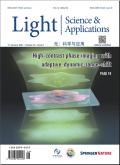Multi-depth switching by triple wavefront modulation of quarter-waveplate geometric phase lenses for vergence-accommodation-matching extended reality.
IF 23.4
Q1 OPTICS
引用次数: 0
Abstract
We present a novel approach to resolving the vergence-accommodation conflict (VAC) in extended reality (XR) optics by introducing a quarter-waveplate (QWP) geometric phase lens (GPL) capable of triple wavefront modulation-focusing, defocusing, and non-modulating at infinity. This polarization-driven behavior is interpreted using contour trajectories on the Poincaré sphere and compared against conventional half-waveplate (HWP) GPLs. Leveraging this property, we propose a bi-stacked QWP GPL module that enables nine distinct varifocal states through polarization-controlled input selection and output filtering. In contrast, HWP-based modules under equivalent stacking conditions are limited to four focal states. The QWP GPL module supports a compact varifocal system spanning a continuous depth range from 24.27 cm to infinity, with a 0.3-diopter interval aligned with the human visual comfort zone. Importantly, the number of representable focal depths scales as 3n for n stacked layers, offering a (1.5)n-fold improvement over the 2n scaling of HWP systems. This enables finer depth transitions using fewer lens units while retaining both compactness and optical modularity, establishing a depth-switchable imaging platform that enhances visual comfort and depth fidelity in next-generation XR display systems.四分之一波片几何相位透镜的三波前调制多深度切换,用于收敛调节匹配扩展现实。
我们提出了一种解决扩展现实(XR)光学中的收敛调节冲突(VAC)的新方法,通过引入四分之一波片(QWP)几何相位透镜(GPL),该透镜能够在无限远处进行三重波前调制-聚焦,散焦和非调制。利用poincar球上的等高线轨迹解释了这种极化驱动行为,并与传统的半波板(HWP) gpl进行了比较。利用这一特性,我们提出了一种双堆叠QWP GPL模块,该模块通过极化控制的输入选择和输出滤波实现了九种不同的可变状态。相比之下,基于hwp的模块在等效堆叠条件下仅限于四个焦点状态。QWP GPL模块支持一个紧凑的变焦系统,跨越24.27厘米到无限的连续深度范围,与人类视觉舒适区一致的0.3屈光度间隔。重要的是,对于n个堆叠层,可表示的焦点深度的数量缩放为3n,比HWP系统的2n缩放提供了(1.5)n倍的改进。这可以使用更少的镜头单元实现更精细的深度转换,同时保持紧凑性和光学模块性,建立一个深度切换成像平台,增强下一代XR显示系统的视觉舒适性和深度保真度。
本文章由计算机程序翻译,如有差异,请以英文原文为准。
求助全文
约1分钟内获得全文
求助全文
来源期刊

Light-Science & Applications
数理科学, 物理学I, 光学, 凝聚态物性 II :电子结构、电学、磁学和光学性质, 无机非金属材料, 无机非金属类光电信息与功能材料, 工程与材料, 信息科学, 光学和光电子学, 光学和光电子材料, 非线性光学与量子光学
自引率
0.00%
发文量
803
审稿时长
2.1 months
 求助内容:
求助内容: 应助结果提醒方式:
应助结果提醒方式:


